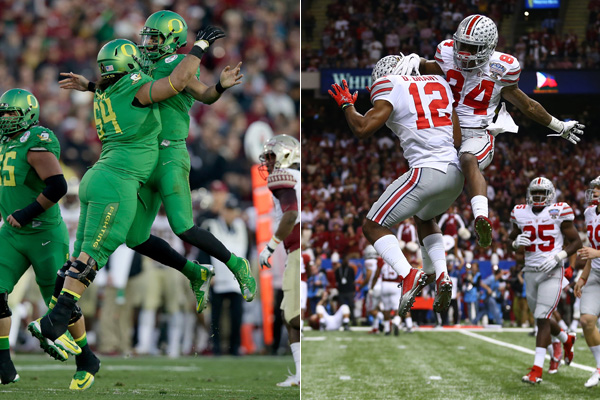January 26, 2010 is the day the University of Oregon football program took its most decisive step into the future.
The previous morning, the Ducks’ then-starting quarterback Jeremiah Masoli stole two laptops and a guitar from a U of O frat house. Masoli pled guilty to the charges and served 12-months probation. Weeks later he was cited for misdemeanor drug and traffic offenses and dismissed from the team.
Oregon football overlord and fetish shoe market provocateur Phil Knight caught wind of the trouble brewing and immediately pressed the go button on his most audacious program to date—completion of a robot.
Somewhere in a basement southeast of Beaverton, Nike engineers had been working since the 1975 death of distance runner Steve Prefontaine to assemble the perfect student-athlete. Coined the MARIOTA program (Mechanized ARtificial Intelligence Offensive Tactical Android), the robot would not only be seen as capable, precise and methodical on the field, but amiable, diverse and engaging off of it.
Ignoring the abject failure of fans to embrace RoboDuck, Knight kicked the program into high gear.
Two seasons later, on Sept. 1, 2012, the MARIOTA was unveiled without fanfare but with quiet quality control and efficiency assurance—just as Knight and his black-op engineers had planned.
The MARIOTA unit, disguised as a redshirt freshman, led the nation’s then-no. 5-ranked Oregon Ducks to a convincing 57-24 season opener victory over Arkansas State. MARIOTA was heretofore unknown even by team watchdogs: “Mariota was on the practice squad last season and was something of a mystery because Oregon closes practices, but he beat out Bryan Bennett for the starter’s job in fall camp,” wrote Ann M. Peterson of the AP in the wake of the robot’s 18-22, 200 yard, three touchdown debut.
At first, Knight and the MARIOTA team were conservative with their new toy. In 2012, they let offensive skill set pieces De’Anthony Thomas and Kenjon Barner (not robots) grab most of the headlines and the credit for the Ducks’ continued rise to the elite of college football.
But slowly, Knight let the throttle out on the MARIOTA unit. Insiders say to date the builders never have run the MARIOTA full-bore, not for fear of overloading its circuits, but out of concern people wouldn’t accept what they were seeing as real.
“If there’s one thing I’ve learned at Nike, it’s that people will believe anything within the context of shoes and outerwear,” Knight was overheard saying at a Rose Bowl tailgater as Blue cheese dressing dripped onto his beard. “Look at the Air Yeezy 2 things or whatever. Someone paid $16 million for red shoes that didn’t even belong to Judy Garland. Once I saw that, I figured—people will buy anything.”
The MARIOTA unit concluded the 2012 campaign going 230 for 336 for 2,677 yards with a Fiesta Bowl victory over Kansas State. The robot team stayed on message coding in a “plausible fallibility” algorithm in 2013 resulting in the completion of 245 passes in 386 attempts for 3,665 yards and a victory over the Texas Longhorns in the Alamo Bowl.
Nike engineers wanted to see what the MARIOTA could really do for his assumptive final campaign. And Knight wanted to push the limits of what people would believe was truly humanly possible. In 2014, the MARIOTA threw 280 completions and only three interceptions in 408 attempts with 4,121 yards passing and a 184.3 rating.
The numbers, Knight said, were beyond the “metaphysical and spiritual and into the realm of ‘no way Jose’.”…But people still ate it up.
Worrying the MARIOTA unit would be outed as an android prior to the championship game, resulting in all kinds of Nike-as-Skynet headlines, (though in the 1,076-page NCAA rulebook currently has no ban on android or synthetic student-athletes) MARIOTA engineers installed tear ducts for the Heisman speech (note, the tears did not actually flow but the MARIOTA did simulate wiping them) and programmed him to throw an end-of-first-half pick in the Rose Bowl.
A Nike quality control insider revealed CFB conspiracy theorists have already all-but-outed the MARIOTA using the Heisman pose engineers coded prior to the 2014 Civil War:
…as well as this play during the Wyoming game:
…along with the fact that his hair has never been out of place, nor has it grown in three seasons:
2012
2013
2014
…as evidence.
Yet the pervasive wisdom going into Monday’s first-ever College Football Championship Game is the MARIOTA is simply a human being who just happens to do everything like a robot would do, except maybe better.
Sy Pfeiffercorn, a post-doctoral fellow at MIT, has been analyzing the MARIOTA for the past three seasons. “His statistics, not to mention aesthetics, are definitely beyond human, but they’re not exactly merely robot either,” he said, pronouncing the word robot, rōbət. “My guess, based on more than 4,277 hours of analysis, would be alien robot.”
An alien robot who has never stolen a laptop. Though that may change if the MARIOTA turns evil someday and needs to break into The Mainframe.
Bettors thus far are showing they have no idea of the actual future they’re witnessing today in no. 8 as they’ve moved the line from the 7-point Oregon favorite opener to 6.5 this week.
“People who bet against robots usually end up dying,” Knight wrote in a memo to the MARIOTA team this week. “I don’t want Buckeye fans to die. But if they lose their shirts so they have to buy a Nike Dri-FIT™ instead. I’m OK with that. LOL.”







